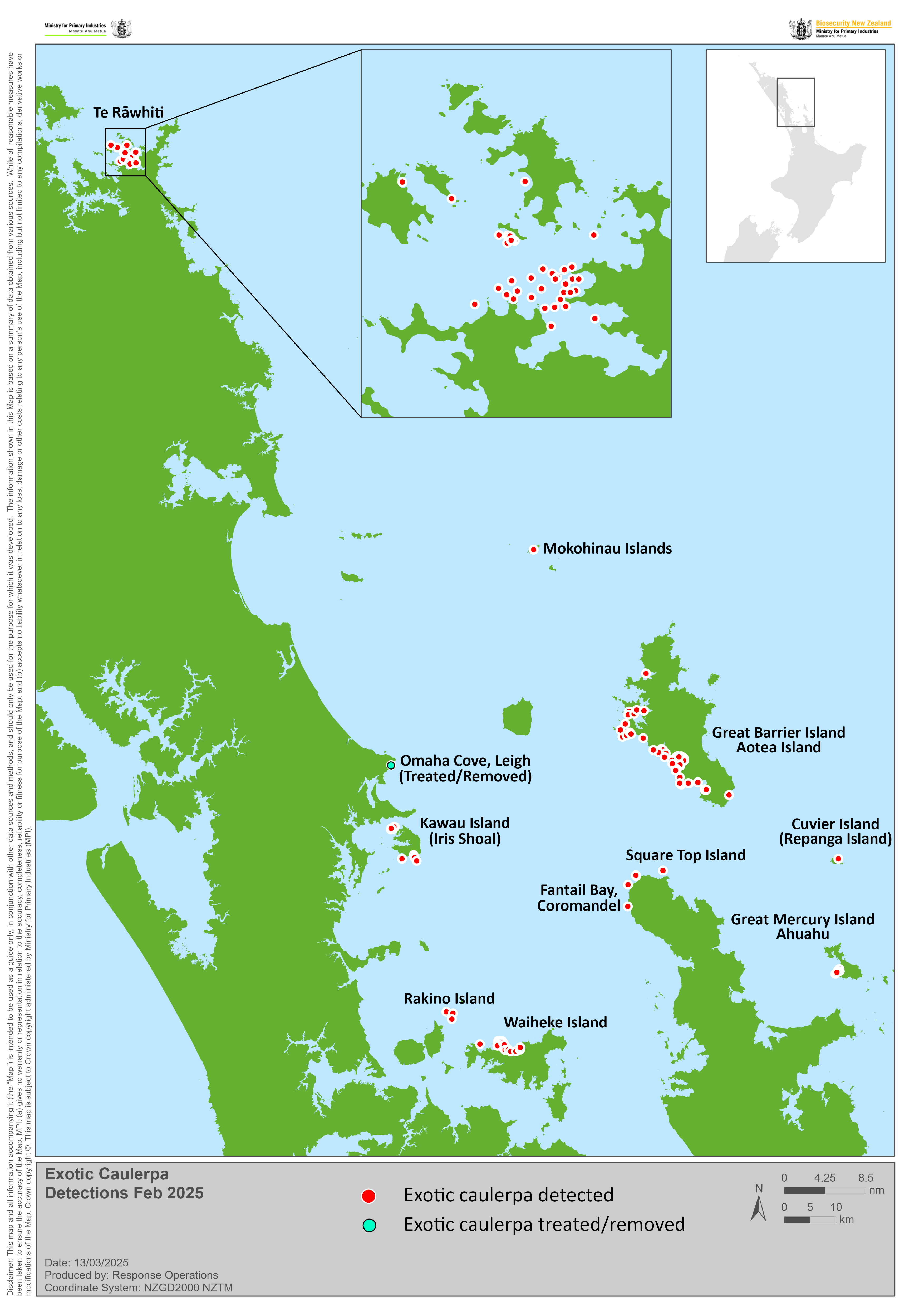Why exotic caulerpa is a risk to NZ
There are two almost identical species of exotic caulerpa now known to be in New Zealand waters – Caulerpa brachypus and Caulerpa parvifolia. Together we refer to them as exotic caulerpa.
These 2 pest seaweeds can spread rapidly, forming large underwater fields.

Exotic caulerpa covers more than 1,500 hectares (August 2024) of the upper North Island seabed. Density ranges from thick carpets in some areas to sparsely distributed plants in others. It can compete with other species for space and upset the balance of local ecosystems.
Where exotic caulerpa has been found
Exotic caulerpa was first found in New Zealand in July 2021 at Aotea Great Barrier Island. It has since been confirmed at Ahuahu Great Mercury Island, Te Rāwhiti Inlet in Northland, Kawau Island, Waiheke Island, Mokohinau Islands, Rakino Island, Fantail Bay, Coromandel Peninsula, Repanga Cuvier Island, Square Top Island and Omaha Cove/Leigh Harbour (although this was a small, discrete patch which has been removed).
It is not known where or when exotic caulerpa first entered New Zealand waters. It is considered likely it arrived on a vessel travelling from Australia or the Pacific. The amount found in the various locations suggests it had been here for several years before its first discovery at Aotea.
Current map of known exotic caulerpa locations

Download a larger, printer-friendly version [PDF, 2.1 MB]
The work being done on exotic caulerpa
Since its discovery in 2021, Biosecurity New Zealand has been working closely with partners, including mana whenua at affected places, local councils, and communities, to try to slow its spread and find or develop potential ways to manage it.
Over $20 million has been spent or allocated to scientific research to understand the pest, surveillance to find it, development and testing of techniques to remove or minimise it, and communications and legal controls to prevent its spread.
While the complete and permanent removal of caulerpa from New Zealand is not feasible with the current tools and the scale of the infestation here, there has been significant work carried out to find ways to suppress it (reducing density to lower the risk of spread) or remove it from specific sites.
Since February 2024, the Government has allocated over $15 million to enable the rapid development of new tools for surveillance and treatment.
Find out about the programme to develop new surveillance and treatment technologies
Help stop the spread
Everyone working in or enjoying our coastal waters can help stop the spread.
If you operate a vessel, go diving or fishing, or you’re out on the water, you should always check your anchor and gear for seaweed before you move to a new location. If you find any seaweed, bag it and put it in the rubbish on shore.
How to stop the spread of exotic caulerpa
You can also help by following the legal restrictions on anchoring and fishing that are in place at 4 of the areas with exotic caulerpa – Aotea Great Barrier Island, Ahuahu Great Mercury Island, Waiheke Island, and Te Rāwhiti Inlet, Northland.
Find out about the exotic caulerpa legal rules in force
Tell us if you find any exotic caulerpa
Keep an eye out for exotic caulerpa species and report suspected sightings to us. Take a photo, if possible, and note the location. Then either:
- freephone 0800 809 966
- or complete the online form at report.mpi.govt.nz








